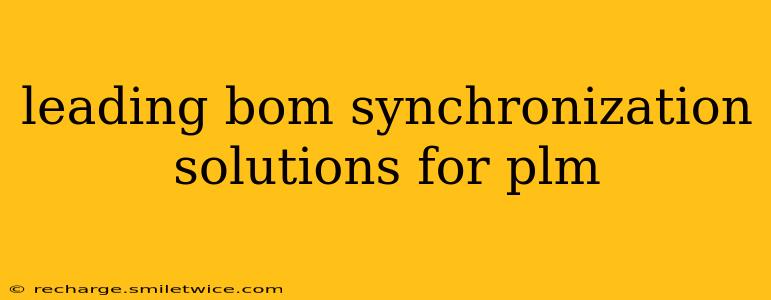Efficient Product Lifecycle Management (PLM) hinges on accurate and up-to-date Bill of Materials (BOMs). Maintaining consistency across different systems and teams is crucial, and BOM synchronization solutions play a vital role in achieving this. This article explores leading solutions for BOM synchronization within PLM, addressing key considerations and challenges.
What is BOM Synchronization in PLM?
BOM synchronization in PLM refers to the automated process of maintaining consistent and accurate BOM data across various systems and departments involved in product development and manufacturing. This includes ensuring that all relevant systems – from engineering design software to ERP and manufacturing execution systems (MES) – reflect the most current version of the BOM. Without robust synchronization, discrepancies can lead to costly errors, production delays, and quality issues.
Why is BOM Synchronization Crucial for PLM?
Accurate and synchronized BOMs are the cornerstone of efficient PLM. Here's why:
- Reduced Errors: Automated synchronization minimizes manual data entry, reducing the risk of human error that can lead to incorrect parts being ordered, manufactured, or assembled.
- Improved Collaboration: Centralized and synchronized BOM data enhances collaboration among engineering, manufacturing, procurement, and other stakeholders. Everyone works from a single source of truth.
- Faster Time to Market: Efficient BOM management accelerates product development cycles by streamlining processes and reducing delays caused by data inconsistencies.
- Enhanced Quality Control: Accurate BOMs ensure that the right components are used in production, minimizing the risk of defects and recalls.
- Cost Savings: Reduced errors, improved efficiency, and minimized waste translate to significant cost savings across the product lifecycle.
Leading BOM Synchronization Strategies & Solutions
Several strategies and solutions facilitate effective BOM synchronization within a PLM environment. These often integrate directly with existing PLM systems or act as bridges between disparate systems. Key approaches include:
-
Direct Integration: This involves integrating the PLM system directly with other relevant systems, such as ERP, MES, and CAD software. Data is automatically transferred and synchronized in real-time or on a scheduled basis. This is generally the most efficient approach but requires careful planning and implementation.
-
Data Replication: This method involves creating copies of BOM data in different systems. While seemingly simple, careful management is needed to ensure consistency across all replicas. Changes in one system must be propagated to others efficiently.
-
API-driven Synchronization: Application Programming Interfaces (APIs) enable automated data exchange between different systems. This provides flexibility and scalability but requires technical expertise to implement and maintain.
-
Cloud-based PLM Solutions: Many modern cloud-based PLM platforms offer built-in BOM synchronization capabilities, simplifying the process and minimizing the need for custom integrations.
What are the best practices for BOM synchronization in PLM?
Effective BOM synchronization requires careful planning and execution. Best practices include:
- Defining a clear data governance strategy: Establish clear rules for data ownership, access, and update procedures.
- Choosing the right synchronization method: Select the method that best suits your specific needs and IT infrastructure.
- Regularly validating data integrity: Implement processes for verifying the accuracy and consistency of BOM data across all systems.
- Establishing a robust change management process: Implement procedures for managing changes to the BOM and ensuring that changes are propagated effectively to all relevant systems.
- Training users: Ensure that all users understand how to use the BOM synchronization system and follow established procedures.
How can I improve the accuracy of my BOMs?
Accuracy is paramount. Consider these strategies:
- Employ automated data entry: Minimize manual data input to reduce errors.
- Implement data validation rules: Ensure data conforms to predefined standards and constraints.
- Regularly audit your BOMs: Conduct periodic reviews to identify and correct inaccuracies.
- Utilize version control: Track changes to the BOM and revert to previous versions if necessary.
What are the challenges of BOM synchronization in PLM?
While highly beneficial, BOM synchronization faces several challenges:
- Data migration and integration complexities: Integrating different systems can be technically challenging and time-consuming.
- Data security and access control: Securing sensitive BOM data is crucial, requiring robust access controls.
- Maintaining data consistency: Ensuring data remains consistent across all systems can be difficult, especially in large and complex organizations.
- Cost of implementation and maintenance: Implementing and maintaining a BOM synchronization solution requires investment in software, hardware, and personnel.
By addressing these challenges strategically and employing the best practices outlined above, organizations can leverage leading BOM synchronization solutions to maximize the value of their PLM investments and achieve significant improvements in efficiency, accuracy, and collaboration throughout the product lifecycle. The right solution will depend on the specific needs and existing infrastructure of each organization. Careful planning and a phased approach are often recommended for successful implementation.
